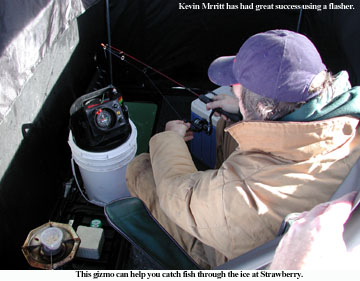|
|
 For
most people, ice fishing is as much about socializing as it is about fishing.
You and your buddies huddle around the portable heater and talk and joke while
you share hot or cold drinks. You may even bring a barbecue and a throw on a
steak or two.
For
most people, ice fishing is as much about socializing as it is about fishing.
You and your buddies huddle around the portable heater and talk and joke while
you share hot or cold drinks. You may even bring a barbecue and a throw on a
steak or two.
That approach is fine, except that it interferes with the serious business of catching fish. Particularly at Strawberry, where it takes concentration and quick reflexes to catch the soft-biting rainbows and cutthroats.
We visited the reservoir on Jan. 1, 2003, and found that the party fishermen were having poor success. Those who were serious about fishing were catching a few, and those who were really working at it were doing well.
“The bite is extremely soft,” people told us time and again.
Those flexible wire bobbers made for ice fishing really helped anglers detect the subtle strikes. The end of the bobber would dip just slightly when a fish mouthed the bait. Fishermen who responded immediately were often rewarded with solid hookups. But those who hesitated, even for a split second, missed the fish.
 Anglers
using sonar (fish finders) had dramatically better success rates. The sonar
helps anglers get their baits to the appropriate levels, where the fish are.
Typically, successful anglers held their bait inches off the bottom until a
fish entered the area. Then, watching the images on the sonar screen, they raised
the bait until it was at the same depth as the fish.
Anglers
using sonar (fish finders) had dramatically better success rates. The sonar
helps anglers get their baits to the appropriate levels, where the fish are.
Typically, successful anglers held their bait inches off the bottom until a
fish entered the area. Then, watching the images on the sonar screen, they raised
the bait until it was at the same depth as the fish.
Perhaps more importantly, the sonar helped anglers know when to pay attention so they noticed and could respond to the subtle strikes.
Kevin Merritt of Salt Lake City was the most successful angler we met. He was cozy in a black ice fishing shack, reeling in fish after fish while those around him had occasional bites. Kevin’s secret was a Vexilar flasher – a high tech sonar device that gives instantaneous readings to show the presence of fish, the depth of the fish, and the depth of his lure.
“This shows what is going on in real time and that make a lot of difference,” Kevin said. His ice fishing success has more than doubled since he started using the flasher last year.
Kevin picks up his rod when the flasher shows a fish in the area. He brings his bait up to the appropriate level and then concentrates so he can “feel” even the lightest bites. He doesn’t rely on a bobber’s movement or anything else. He just senses the bite by detecting a different feel.
Traditional fish finders use a LCD screen that shows several seconds worth of data, as images move across the screen. The image being created on the left edge of the screen is almost real time but the rest of the screen is showing past history. Many anglers don’t understand that and focus on the fish symbols moving across the screen. Those symbols can be useful when trolling but they aren’t of much value when jigging to finicky fish.
Some high-end fish finders have a flasher function, but they aren’t as good or as fast as dedicated units.
Kevin was using a FL-8 SLT model, which is fine for most Utah applications. Vexilar flashers are sold at Galyan’s stores. The Vexilar web site offers an excellent article on how to use the things: http://www.vexilar.com/help/tips/tip013.html
Kevin was using Foxee jigs tipped with wax worms or bits of night crawlers. Other anglers having good success were using Foxee jigs or glo-colored mini-jigs tipped with various baits. In general, people fishing Powerbait caught fewer fish but more rainbows. People fishing jigs tipped with bait caught more fish and more cutthroats.
Dan Lewis of West Jordan had success fishing white jigs tipped with Power Maggots or Power Corn. He had a small stove and was frying a small rainbow right there on the ice. “It’s more fun when you can eat them as you catch them,” he said.
Tom Jackman caught his biggest fish, an 18-inch cutt, fishing a tan jig tipped with a bit of cheese from his sandwich.
Remember the new regulations that took effect on Jan. 1. Strawberry has a 4-fish limit and only 3 can be cutthroats. All cutts from 15-22 inches must be immediately released. Most cutthroats fall into that slot and will have to be released.
Read about the new regulations: http://www.wildlife.utah.gov/news/02-12/strawberry.html
Learn how to tell rainbows from cutthroats at Strawberry: http://www.wildlife.utah.gov/straw10.htm